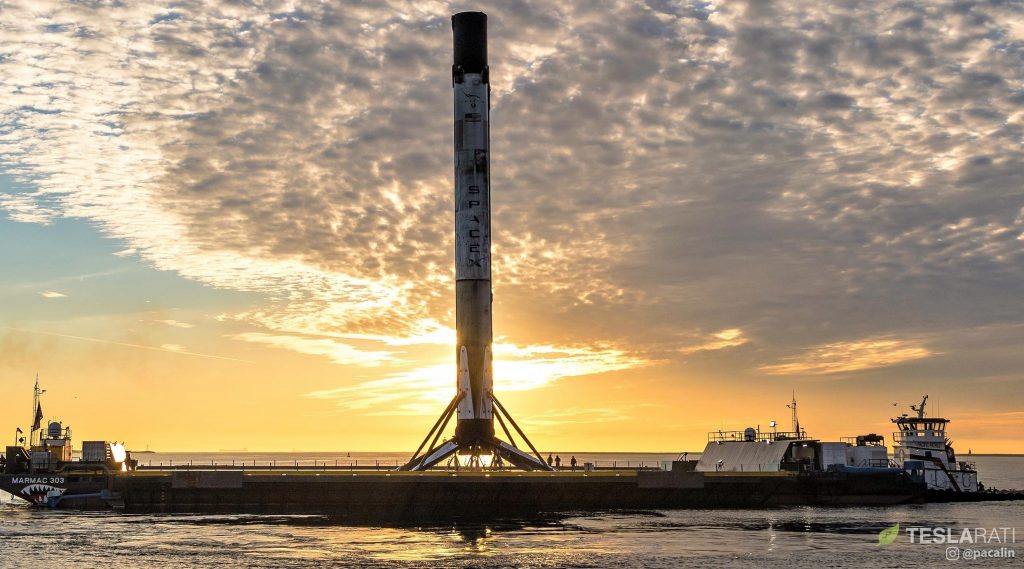For the first time in almost three years, a SpaceX Falcon 9 booster has returned to a California port after a successful West Coast launch and landing.
On September 16th, 2021, less than three days after successfully launching SpaceX’s first West Coast Starlink mission and helping orbit the first batch of 51 upgraded Starlink satellites with ‘space lasers,’ Falcon 9 booster B1049 sailed into the Port of Long Beach. Riding on drone ship Of Course I Still Love You (OCISLY), B1049’s arrival is the first time a SpaceX rocket has returned to a California port since January 2019 – 32 months ago.
If SpaceX’s Starlink V1.5 manufacturing is up to the task, though, there may never again be such a substantial gap between West Coast booster returns – or launches, for that matter.
In a coincidental and perhaps fitting bit of symmetry, it was actually Falcon 9 booster B1049 that last returned to Port of Los Angeles on January 13th, 2019 and then ended the almost three-year West Coast drone ship recovery hiatus on September 16th, 2021. In September 2018, almost exactly three years ago, B1049 – the fourth upgraded Block 5 booster built by SpaceX – launched for the first time.
Iridium-8 – SpaceX’s last West Coast drone ship recovery until this week – was the booster’s second mission. While not quite as spry as its newer siblings, B1049 nevertheless managed to support seven more orbital launches before it returned to Vandenberg Air (now Space) Force Base for flight #10 – becoming the second SpaceX booster ever to reach double digits in the process. Falcon 9 B1049 is now the oldest living booster in SpaceX’s fleet and has averaged one launch every 100 days over its storied three-year life.
Falcon 9 B1051, SpaceX’s other ten-flight booster, has managed a slightly better average of one launch every ~80 days. However, newer boosters B1058 and B1060 have absolutely smashed the records of their predecessors, achieving an average of one launch every 45 days over their eight-flight careers.
Ultimately, SpaceX is expected to operate two or three Falcon boosters out of VAFB to support an average cadence of as many as 12 polar or semi-polar Starlink launches per year – hopefully beginning with Starlink 2-1 on September 13th. According to Spaceflight Now, SpaceX is also preparing to restart East Coast Starlink launches – likely to similar semi-polar orbits – as early as October. With any luck, SpaceX’s Starlink factory will be able to get back into its stride and ramp up V1.5 satellite production to match or exceed the ~120 V1.0 satellites it was recently building each month.
Stay tuned for updates on SpaceX’s next Starlink launch – both from the East Coast and West Coast.


buy ivermectin uk – buy ivermectin uk cost carbamazepine 200mg
buy accutane 40mg online cheap – decadron price zyvox 600mg oral
buy amoxil without a prescription – brand ipratropium 100mcg buy generic combivent for sale
order azithromycin 250mg pills – order tindamax 300mg generic buy bystolic 20mg pills
order prednisolone 10mg for sale – progesterone 200mg pills order progesterone 200mg pills
furosemide cheap – buy lasix 40mg pills buy betnovate 20 gm sale
acticlate usa – ventolin brand glucotrol 10mg cost
order augmentin 375mg without prescription – buy cymbalta no prescription order cymbalta 20mg generic
buy semaglutide generic – vardenafil 10mg oral generic cyproheptadine
tizanidine sale – plaquenil 200mg oral hydrochlorothiazide 25mg brand
buy cialis pill – viagra buy online female viagra cvs
buy cheap atorvastatin – buy lisinopril paypal buy zestril 2.5mg online
omeprazole pill – order generic metoprolol 50mg tenormin 50mg pills
methylprednisolone 4mg over counter – aristocort usa buy aristocort 10mg sale
buy generic desloratadine over the counter – buy desloratadine for sale buy dapoxetine 90mg online
purchase misoprostol generic – buy orlistat 120mg online diltiazem drug
buy generic zovirax 400mg – order zyloprim without prescription crestor over the counter
order motilium 10mg generic – generic cyclobenzaprine 15mg purchase flexeril for sale
how to buy domperidone – order flexeril 15mg for sale cyclobenzaprine for sale
inderal generic – inderal 20mg canada methotrexate 10mg pills
warfarin cheap – buy metoclopramide without a prescription cozaar pill
buy generic nexium online – order topiramate online imitrex 50mg uk
order levaquin 250mg pill – levaquin 250mg uk buy ranitidine pills for sale
buy generic zofran 4mg – buy generic simvastatin for sale zocor order online
order valtrex 500mg online cheap – buy finasteride 5mg pills buy forcan sale